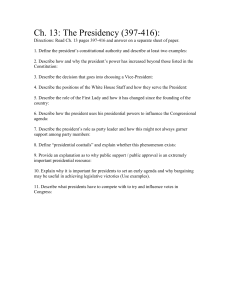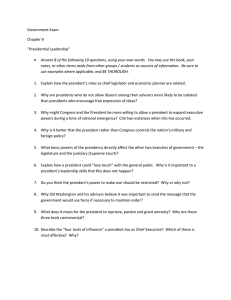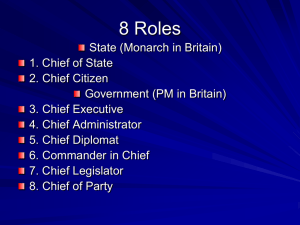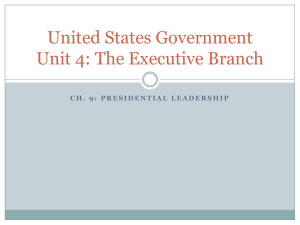Document 15555268
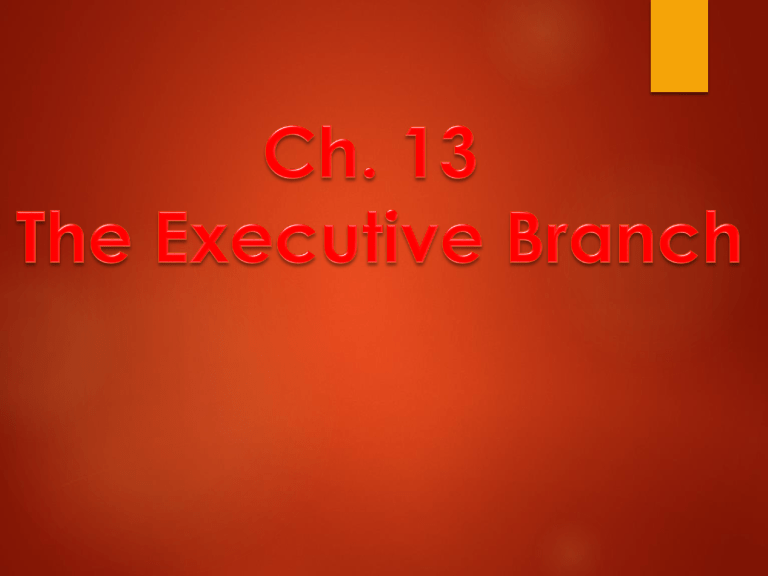
I. The
Presidents
A. Great
Expectations
B. Who They
Are
1. Americans want a president who is powerful and who can do good like Washington, Jefferson,
Lincoln, Roosevelt, and Kennedy.
Yet Americans do not like a concentration of power because they are individualistic and skeptical of authority.
1. Formal Requirements:
Must be 35 years old
Must be a natural-born citizen
Must have resided in U.S. for 14 years
2. Informal “Requirements”:
White, Male, Protestant (With some exceptions)
3. All manner of professions, but mostly political ones (former state governors, for example)
C. How They
Got There
1. Elections: The Normal Road to the White House
Once elected, the president serves a term of four years.
In 1951, the 22 nd Amendment limited the number of terms to two.
2. Succession
The vice president succeeds if the president leaves office due to death, resignation, or removal.
Under the 25 th Amendment, the vice president becomes acting president if the vice president and president’s cabinet determine that the president is disabled
C. How They
Got There
(cont.)
3. Impeachment
Impeachment is an accusation, requiring a majority vote in the House.
Charges may be brought for “Treason,
Bribery, or other high Crimes and
Misdemeanors.”
If impeached, the president is tried by the
Senate with the Chief Justice presiding.
Only two presidents have been impeached—Andrew Johnson and Bill
Clinton—and neither was convicted.
II. Presidential
Powers
A. Constitutional
Powers of the
President b
B. The
Expansion of
Power
C.
Perspectives on Presidential
Power
1. Presidents may develop new roles for and expand power of the office.
1. During the 1950s and 1960s people favored a powerful president.
2. By the 1970s, presidential power was checked and distrusted by the public.
III. Running the
Government:
A. As Chief
Executive
B. The Vice
President
C. The Cabinet
1. the president presides over the administration of government.
1. Constitution: “take care that the laws be faithfully executed”
2. Today, federal bureaucracy spends $2.5 trillion a year and numbers more than 4 million employees.
3. Presidents appoint 500 high-level positions and 2,500 lesser jobs.
1. Basically just “waits” for things to do
2. Power has grown over time, as recent presidents have given their VPs important jobs
1. Presidential advisors, not in Constitution
2. Made up of 14 cabinet secretaries and one
Attorney General, confirmed by the Senate
D. Cabinet
Departments
E. The
Executive
Office
1. Made up of policymaking and advisory bodies
Three principle groups: NSC, CEA, OMB
1.
National
1. Security Council (NSC)
Created in 1947 to coordinate the president’s foreign and military policy advisers
Members include the president, vice president, secretary of state and defense, and managed by the president’s national security adviser
2. Council of Economic Advisers (CEA)
A three-member body appointed by the president to advise on economic policy
3. Office of Management and Budget (OMB)
Performs both managerial and budgetary functions, including legislative review and budgetary assessments of proposals
F. The White
House Staff
G. The First
Lady
1. Chief aides and staff for the president— some are more for the White House than the president
2. Presidents rely on their information and effort but presidents set tone and style of
White House
1. No official government position, but many get involved politically
2. Recent ones focus on a single issue, e.g.,
Hillary Clinton and health care
IV.
Presidential
Leadership of
Congress: The
Politics of
Shared Powers
A. Chief
Legislator
1. Veto: The president can send a bill back to
Congress with his reasons for rejecting it. It may be overridden with 2/3 support of both
Houses.
2. Pocket Veto: A president can let a bill die by not signing it when Congress adjourns within 10 days of submitting a bill.
3. Line Item Veto: ability to veto parts of a bill-
-some state governors have it, but not the president
Vetoes are mostly used to prevent legislation.
B. Party
Leadership
1. The Bonds of Party
Being in the president’s party creates a psychological bond between legislators and presidents, increasing agreement.
2. Slippage in Party Support
Presidents cannot always count on party support, especially on controversial issues.
3. Leading the Party
Presidents can offer party candidates support and punishment by withholding favors.
Presidential coattails occur when voters cast their ballots for congressional candidates of the president’s party because they support the president. Races are rarely won in this way.
a b
a b
C. Public
Support
D. Legislative
Skills
1. Public Approval
A source of presidential leadership of
Congress
Public approval gives the president leverage, not command; it does not guarantee success
2. Mandates
Perception that the voters strongly support the president’s character and policies
Mandates are infrequent, but presidents claim a mandate anyway
1. Bargaining: concessions for votes, occurs infrequently
2. Being strategic, presidents increase chances for success by exploiting
“honeymoon” at beginning of term
3. Presidents may set priorities to influence
Congress’ agenda; president is nation’s key agenda builder
4. Skills must compete with other factors that may affect Congress; they are not at the
V. The
President and
National
Security Policy
A. Chief
Diplomat
B.
Commanderin-Chief
1. Negotiates treaties with other countries
Treaties must be ratified by 2/3 vote in the
Senate
2. Use executive agreements to take care of routine matters with other countries
3. May negotiate for peace between other countries
4. Lead U.S. allies in defense and economic
1. Writers of the Constitution wanted civilian control of the military.
2. Presidents often make important military decisions.
3. Presidents command a standing military and nuclear arsenal—unthinkable 200 years ago
C. War Powers
D. Crisis
Manager
E. Working with Congress
1. Shared War Powers in Constitution
Congress has the power to declare war.
President, as Commander-in-Chief, can commit troops and equipment in conflicts
2. War Powers Resolution (1973)
Intended to limit the president’s use of the military
Requires president to consult with Congress prior to using military force and withdraw forces after 60 days unless Congress declares war or grants and extension
Presidents see the Resolution as unconstitutional
3. Presidents continue to test the constitutional limits of using the military in foreign conflicts.
1. The role the president plays can help or hurt the presidential image.
2. With current technology, the president can act much faster than Congress to resolve a crisis.
1. President has lead role in foreign affairs
2. Presidents still have to work with Congress for support and funding of foreign policies.
VI.Power from the People:
The Public
Presidency
A. Going
Public
B. Presidential
Approval
1. Public support is perhaps the greatest source of influence a president has.
2. Presidential appearances are staged to get the public’s attention.
3. As head of state, presidents often perform many ceremonial functions, which usually result in favorable press coverage.
1. Receives much effort by the White House
2. Product of many factors: predispositions,
“honeymoon,” rally events
Changes can highlight good or bad decisions
C. Policy
Support
D. Mobilizing the Public
1. Presidents attempt to gain public support through televised messages, with little success
The public may not be receptive to the president’s message or misperceive it all together.
1. The president may attempt to motivate the public to contact Congress.
2. A difficult task, given inattentive and apathetic public
3. May backfire: a lack of response speaks loudly
VII. THE
BUREAUCRACY
KEY DEFINITIONS
AND FACTS
A. KEY FEATURES
OF A
BUREAUCRACY
1. A bureaucracy is a large, complex organization of appointed officials. The federal bureaucracy includes all of the agencies, people, and procedures through which the federal government operates.
There are approximately 2.7 million civilian and 1.4 million military federal government employees.
Half of all the civilian federal employees work for the
Department of Defense and an additional 28 percent work for the Postal Service.
Hierarchical authority-a chain of command in which authority follows from the top down.
Job specialization-each employee has defined duties and responsibilities.
Formal rules-all employees must follow established procedures and regulations.
B. THE CABINET
DEPARTMENTS
There are 15 cabinet departments. With the exception of the Department of Justice (headed by the attorney general), each department is headed by a secretary. All 15 heads are chosen by the president and approved by the Senate.
The Treasury Department has authority over the printing of currency.
Cabinet secretaries often develop a strong loyalty to their departments. As a result, cabinet members are often not close presidential advisors.
C. THE
INDEPENDENT
REGULATORY
AGENCIES
1. Created to protect the public by regulating key sectors of the economy.
The Interstate Commerce Commission (ICC),
Securities and Exchange Commission (SEC), National
Labor Relations Board (NLRB), and the Federal
Reserve Board (FRB) are among the best-known independent regulatory agencies.
The independent regulatory agencies are led by small commissions appointed by the president and confirmed by the Senate.
Note that the commissioners cannot be removed by the president during their terms of office.
D. THE
GOVERNMENT
CORPORATIONS
Government corporations provide a service that could be provided by the private sector.
The Corporation for Public Broadcasting , the
Tennessee Valley Authority , Amtrak , and the
U.S. Postal Service are the best known government corporations.
E. INDEPENDENT
EXECUTIVE
AGENCIES
1. The independent executive agencies include most of the non- cabinet departments.
The National Aeronautics and Space
Administration (NASA) , the National Science
Foundation (NSF) , the Environmental Protection
Agency (EPA), and the Government Services
Administration (GSA) are the best known independent executive agencies.
VIII. IMPLEMENTATION
AND REGULATION
A. IMPLEMENTATION
Implementation is the translation of policy goals into rules and standard operating procedures.
Implementation can break down for a number of reasons, including conflicting goals, a faulty program design, a lack of financial resources, and the fragmentation of responsibilities.
For example, prior to the formation of the Office of Homeland Security in 2001, forty-six federal agencies were involved in counterterrorism efforts.
Congress usually provides federal agencies with general mandates. As a result, the agencies often have administrative discretion to set specific guidelines for a given problem or situation.
B. REGULATION
Regulation is the use of governmental authority to control or change practices in the private sector.
The Supreme Court first upheld the right of government to regulate businesses in Munn v.
Illinois (1877).
During the administrations of presidents Reagan and George W. Bush, the federal government deregulated or lifted a number of restrictions on business. For example, in 1984, Congress disbanded the Civil Aeronautics Board (CAB).
IX. THE PRESIDENT
AND THE
BUREAUCRACY
A. APPOINTMENTS
Presidents have the power to appoint senior agency heads and subheads. This enables the president to exercise influence over an agency.
B. B. EXECUTIVE
ORDERS
The president's power is limited. The Senate has the power to approve the president's appointments. In addition, agency heads often develop a strong loyalty to their departments and thus do not aggressively pursue a president's policy agenda.
An executive order is a directive, order, or regulation issued by the president.
Executive orders are based on constitutional or statutory authority and have the force of law.
C. ECONOMIC
POWERS
The president may use the Office of Management and Budget to cut or add to an agency's budget.
It is important to remember that Congress has the sole power to appropriate funds to an agency.
Example since the Republicans took control of the house in 2010 they have cut the IRS budget by more than 20% because of mismanagement.
X. CONGRESS
AND THE
BUREAUCRACY
A. DIVIDED
AUTHORITY
The United States has a system of divided supervision in which both the president and
Congress exercise authority over the federal bureaucracy.
The system of divided supervision creates checks and balances while at the same time often encouraging agencies to play one branch of government against the other.
B. OVERSIGHT 1. Congress has the responsibility to exercise legislative oversight over the federal bureaucracy.
2. Congress uses the following methods to oversee the federal bureaucracy:
Exercising budgetary control by setting aside funds for each agency.
Holding hearings and conducting investigations.
Reorganizing an agency.
Setting new guidelines for an agency.
Spreading out responsibilities in order to prevent anyone agency from becoming too powerful.
XI. INTEREST
GROUPS AND THE
BUREAUCRACY
A. IRON TRIANGLES An iron triangle is an alliance among an administrative agency, an interest group, and a congressional committee.
Each member of the iron triangle provides key services, information, or policy for the others.
Iron triangles are so pervasive and powerful that they are often called sub-governments.
B. ISSUE NETWORKS
An issue network includes policy experts, media pundits, congressional staffs, and interest groups who regularly debate an issue.
The president often fills agency positions with people from an issue network who support his or her views.
Note: Be sure that you know the difference between an iron triangle and an issue network.
An iron triangle has three interlocking pointsan administrative agency, an interest group, and a congressional committee. An issue network consists of a wide range of people who debate major public policies.

